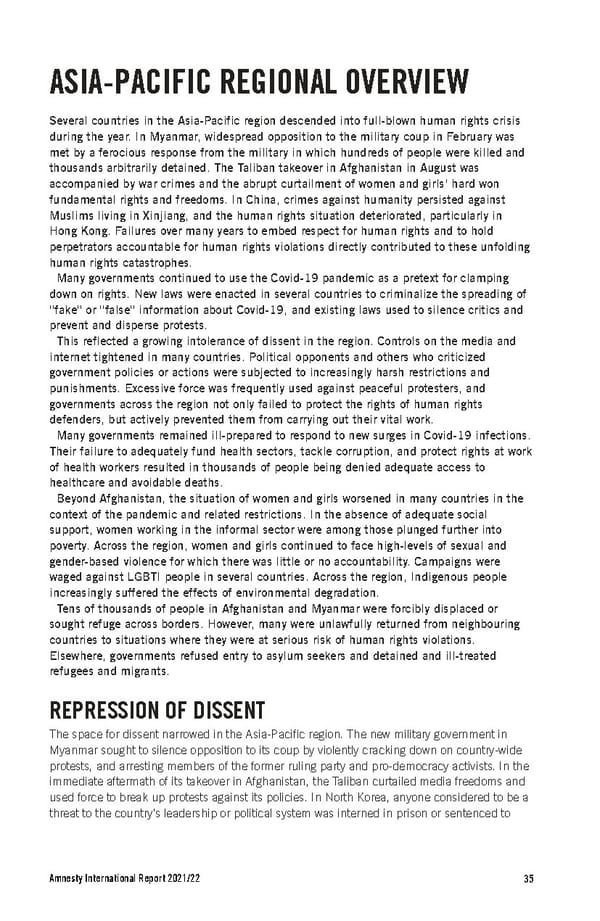ASIA-PACIFIC REGIONAL OVERVIEW Several countries in the Asia-Pacific region descended into full-blown human rights crisis during the year. In Myanmar, widespread opposition to the military coup in February was met by a ferocious response from the military in which hundreds of people were killed and thousands arbitrarily detained. The Taliban takeover in Afghanistan in August was accompanied by war crimes and the abrupt curtailment of women and girls’ hard won fundamental rights and freedoms. In China, crimes against humanity persisted against Muslims living in Xinjiang, and the human rights situation deteriorated, particularly in Hong Kong. Failures over many years to embed respect for human rights and to hold perpetrators accountable for human rights violations directly contributed to these unfolding human rights catastrophes. Many governments continued to use the Covid-19 pandemic as a pretext for clamping down on rights. New laws were enacted in several countries to criminalize the spreading of “fake” or “false” information about Covid-19, and existing laws used to silence critics and prevent and disperse protests. This reflected a growing intolerance of dissent in the region. Controls on the media and internet tightened in many countries. Political opponents and others who criticized government policies or actions were subjected to increasingly harsh restrictions and punishments. Excessive force was frequently used against peaceful protesters, and governments across the region not only failed to protect the rights of human rights defenders, but actively prevented them from carrying out their vital work. Many governments remained ill-prepared to respond to new surges in Covid-19 infections. Their failure to adequately fund health sectors, tackle corruption, and protect rights at work of health workers resulted in thousands of people being denied adequate access to healthcare and avoidable deaths. Beyond Afghanistan, the situation of women and girls worsened in many countries in the context of the pandemic and related restrictions. In the absence of adequate social support, women working in the informal sector were among those plunged further into poverty. Across the region, women and girls continued to face high-levels of sexual and gender-based violence for which there was little or no accountability. Campaigns were waged against LGBTI people in several countries. Across the region, Indigenous people increasingly suffered the effects of environmental degradation. Tens of thousands of people in Afghanistan and Myanmar were forcibly displaced or sought refuge across borders. However, many were unlawfully returned from neighbouring countries to situations where they were at serious risk of human rights violations. Elsewhere, governments refused entry to asylum seekers and detained and ill-treated refugees and migrants. REPRESSION OF DISSENT The space for dissent narrowed in the Asia-Pacific region. The new military government in Myanmar sought to silence opposition to its coup by violently cracking down on country-wide protests, and arresting members of the former ruling party and pro-democracy activists. In the immediate aftermath of its takeover in Afghanistan, the Taliban curtailed media freedoms and used force to break up protests against its policies. In North Korea, anyone considered to be a threat to the country’s leadership or political system was interned in prison or sentenced to Amnesty International Report 2021/22 35
 Amnesty International Report 2021/22 Page 34 Page 36
Amnesty International Report 2021/22 Page 34 Page 36